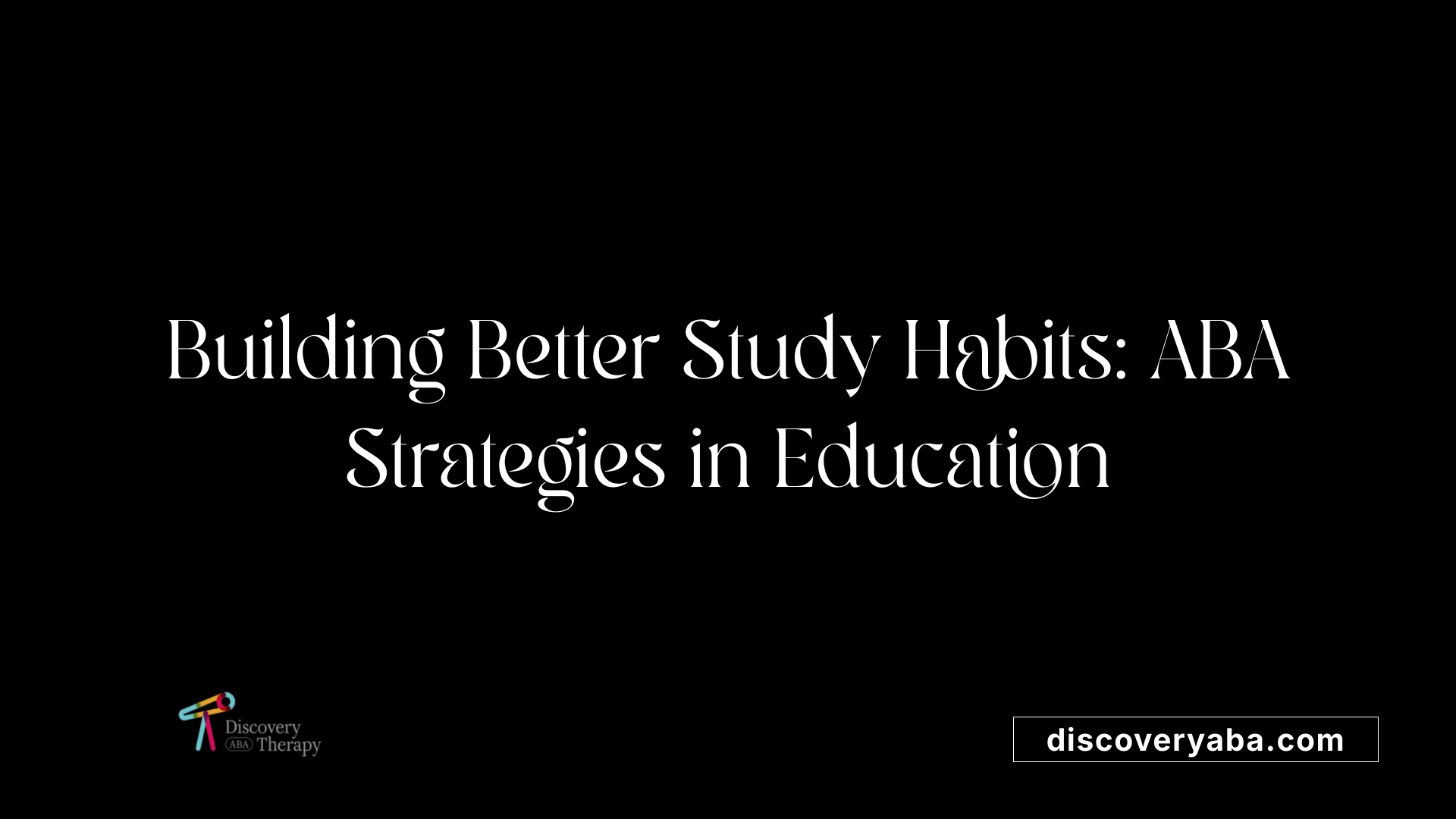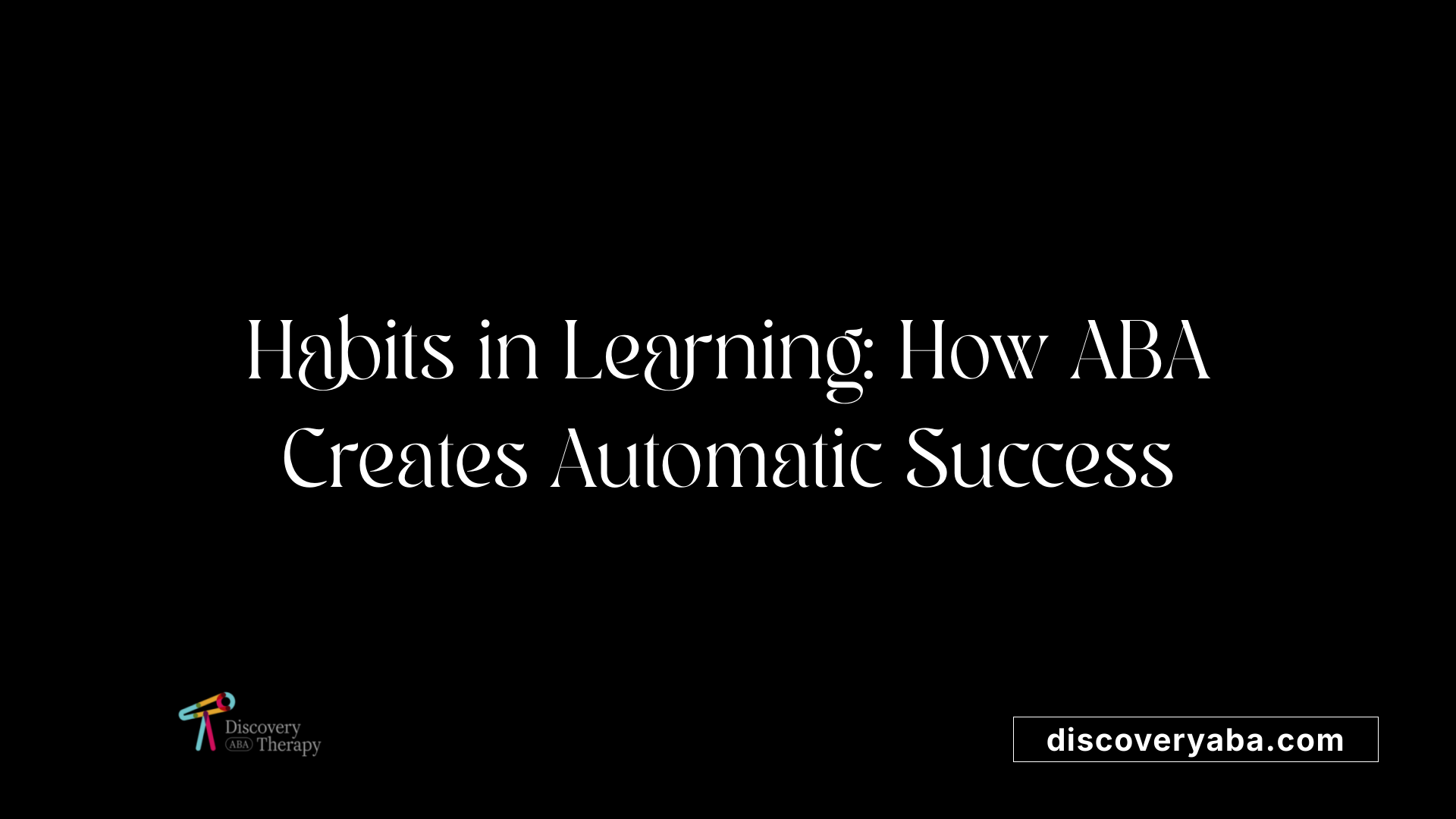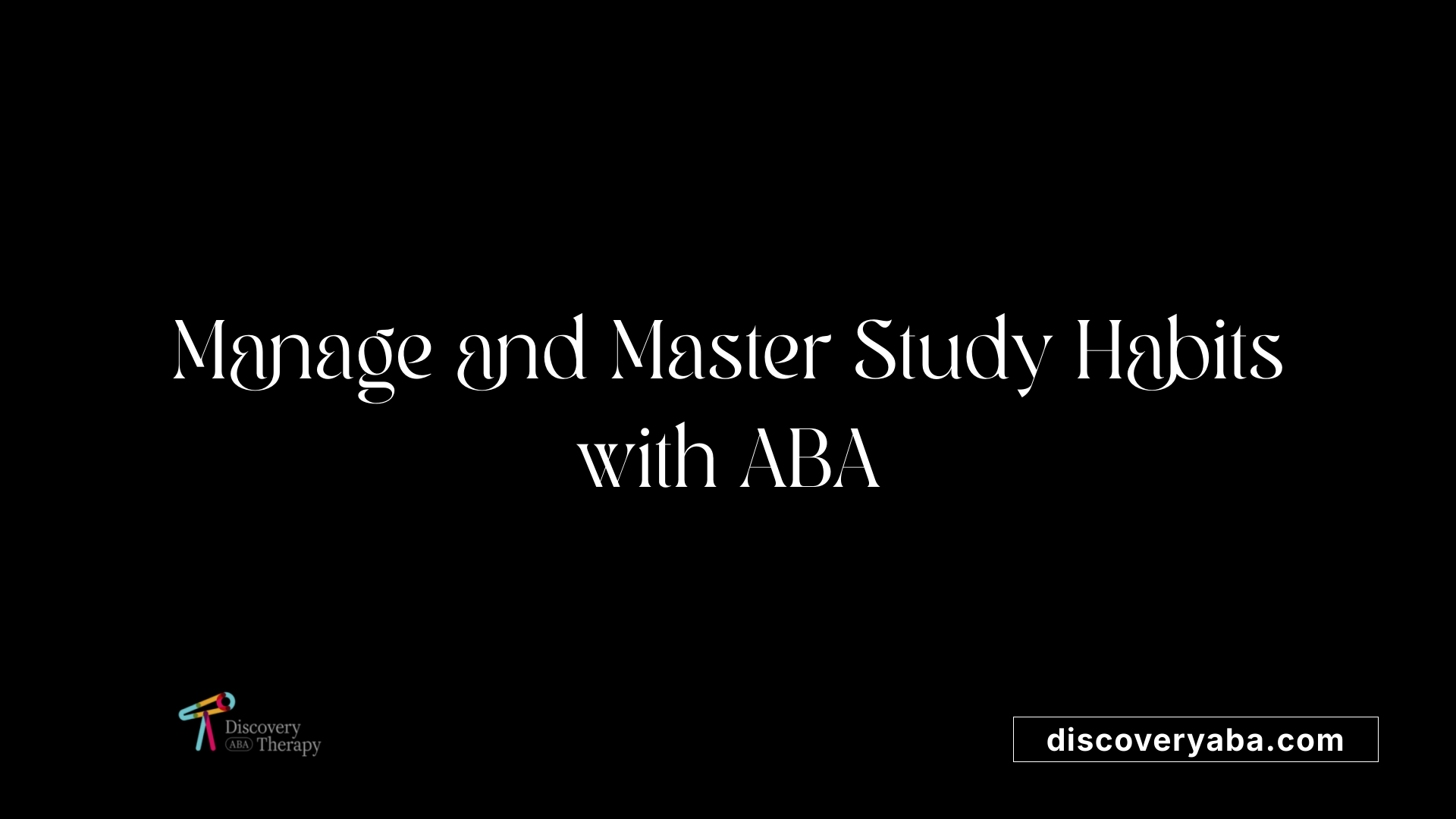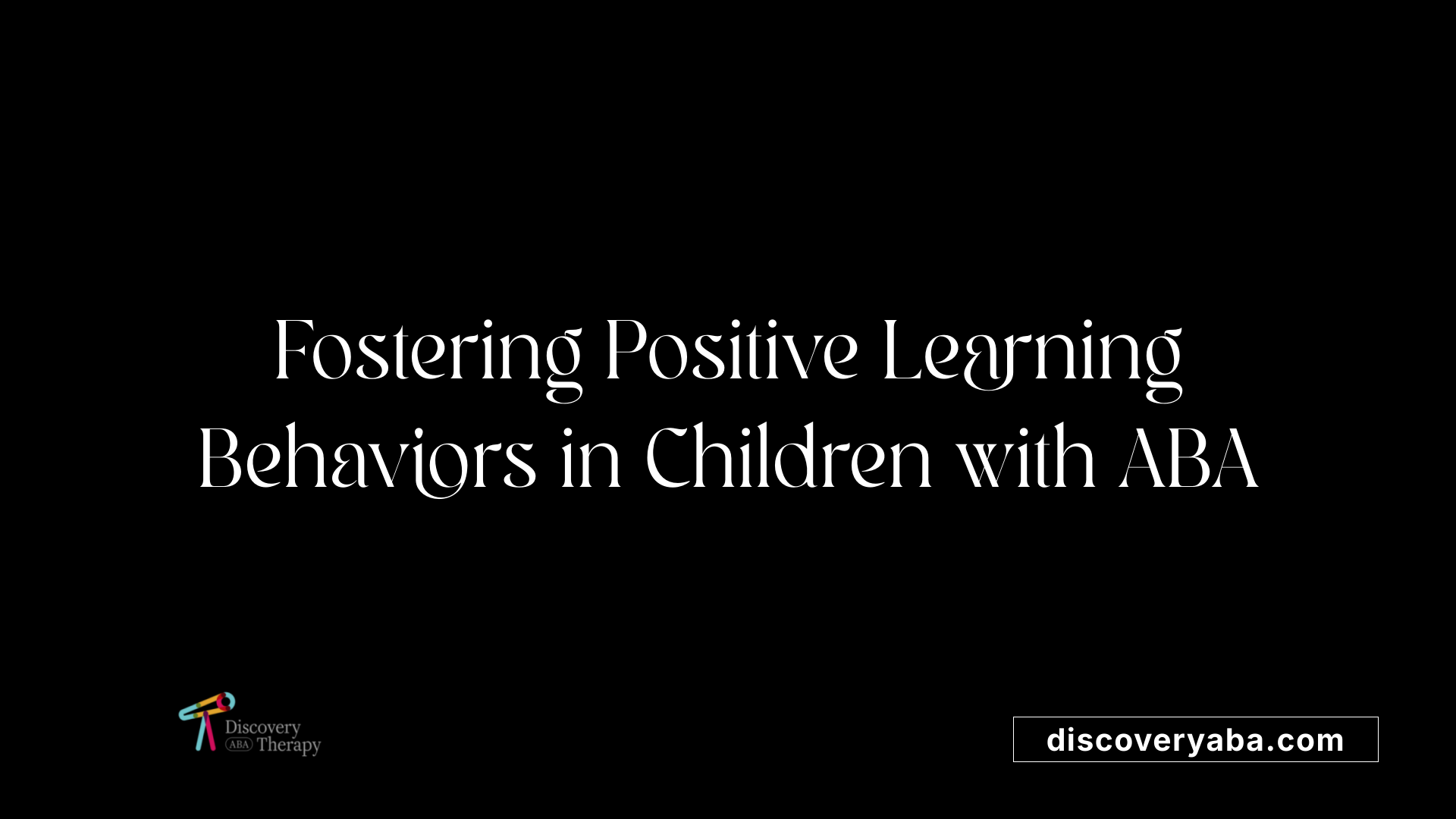ABA strategies for building study habits
Transforming Study Routines with Proven ABA Approaches

Unlocking the Power of ABA for Academic Success
Applied Behavior Analysis (ABA) offers a scientifically supported framework for cultivating effective study habits. By leveraging systematic reinforcement, prompting, behavior analysis, and fostering healthy routines, educators and parents can guide learners toward sustained academic independence. This article explores how ABA strategies are applied to develop and reinforce study behaviors, ensuring long-lasting success across diverse educational settings.
Foundations of ABA in Educational Habits

How are ABA strategies used to develop effective study habits and routines?
Applied Behavior Analysis (ABA) employs a range of techniques to help individuals establish and maintain effective study habits and routines. One fundamental approach is systematic reinforcement: rewarding behaviors like consistent study schedules, organized note-taking, or completing assignments on time with praise, tokens, or other preferred reinforcers. This encourages learners to repeat these behaviors.
Breaking down complex study tasks into smaller, manageable steps through task analysis makes it easier for students to develop routines and build independence. For example, a student might learn to plan their study session, gather materials, and review notes in sequential steps, each reinforced individually.
Prompts such as visual cues, checklists, or verbal reminders support learners in initiating and maintaining productive behaviors. Over time, these prompts are gradually faded to foster independent habits.
Spacing study sessions—also known as spaced repetition—and interleaving different subjects improve retention and keep students engaged. Using mnemonic devices can further enhance memory and make studying more effective.
Data collection plays a crucial role by tracking progress, allowing educators and parents to assess what strategies work best and adjust routines accordingly. Continuous monitoring ensures that study habits are being reinforced and maintained.
Teaching self-management skills like self-prompting, self-reinforcement, and checklists empowers learners to independently follow their routines. These strategies foster self-control and long-term adherence, key for academic success.
In summary, ABA techniques—such as reinforcement, task analysis, prompting, data-driven adjustments, and self-management—are vital in developing durable, effective study habits that support academic achievement and lifelong learning skills.
The Role of Habits in Learning Efficiency

How are habits formed through ABA principles?
Habits are built through a process that involves a repeating cycle of cues, routines, and reinforcement, as outlined by Duhigg (2012). In educational settings, this cycle starts with a specific cue or trigger—such as a set time for study or entering a classroom—that prompts a certain behavior.
Once the cue occurs, the individual performs the routine or behavior—like reviewing notes, completing assignments, or engaging in practice exercises. This routine is then reinforced, either through positive feedback, praise, intrinsic satisfaction, or tangible rewards.
Research by Neal, Wood, and Quinn (2006) demonstrates that behaviors carried out consistently in stable environments tend to become automatic over time. This automaticity reduces the cognitive load, making it easier to maintain the behavior without deliberate effort.
In the context of ABA, integrating reinforcement systematically with environmental cues aids in solidifying these habits. For example, providing praise or tokens immediately after a student completes a task when prompted by a visual cue helps reinforce the routine, encouraging persistence and consistency.
Over time, these behaviors can become ingrained habits that support ongoing learning and adherence to educational strategies. This systematic approach ensures habits are resilient, sustainable, and ultimately enhance engagement and effectiveness in learning activities.
Practical ABA Techniques for Study Routine Development

How can ABA techniques like reinforcement and prompting be applied to enhance study skills?
Applied Behavior Analysis (ABA) offers effective strategies to improve students' study routines and academic skills. Central to these strategies are reinforcement, prompting, and task analysis, which work together to promote independence and sustained engagement.
Reinforcement involves providing positive rewards—such as praise, stickers, or extra break time—when students display desirable behaviors like staying focused or completing tasks. This consistent praise encourages repetition of those behaviors, helping students develop stronger study habits. For example, rewarding a child after completing a math worksheet motivates them to continue practicing with enthusiasm.
Prompting and fading techniques guide students through new or challenging tasks. Prompts can be verbal cues, visual aids, or physical guidance that assist in understanding instructions or steps within a task. Over time, prompts are gradually reduced or faded to foster independence. For instance, initially pointing to a word while encouraging reading, then gradually removing the cue, helps the student learn to read without assistance.
Task analysis breaks down complex study activities into smaller, manageable steps, making tasks less intimidating and easier to master. Activities like writing a report or solving a math problem are divided into discrete actions—such as outlining, drafting, and editing—to build confidence and competence incrementally.
By combining these ABA techniques, educators and parents can create a structured, supportive learning environment. Visual schedules and checklists reinforce routines, while ongoing data collection ensures interventions are personalized and effective. As a result, students develop better focus, independence, and motivation to succeed academically, laying a foundation for lifelong learning skills.
Using ABA to Manage Behaviors and Build Study Routines

How can ABA principles assist in behavior management to support the development of study habits?
Applied Behavior Analysis (ABA) offers practical tools for establishing effective study routines through behavior management strategies. One primary approach involves the use of reinforcement—rewarding positive studying behaviors with praise, tokens, or tangible rewards to increase their occurrence. This method helps motivate learners to adopt and maintain productive study habits.
Prompting and fading are also essential techniques. Prompts provide initial cues or assistance to guide students in performing study tasks correctly. Gradually reducing these prompts supports independence over time, fostering self-reliance in study routines.
Breaking complex tasks into smaller, manageable steps via task analysis makes learning less overwhelming and helps learners master each component systematically. This step-by-step approach not only simplifies learning but also enhances confidence and consistency.
Ongoing data collection plays a crucial role. Recording the frequency, duration, and other behaviors related to studying allows educators and caregivers to track progress accurately. This data informs tailored interventions that cater to individual needs, optimizing the learning process.
In addition to behavioral techniques, environmental modifications significantly support study habits. Creating dedicated, quiet study spaces—free from distractions—aligns with ABA strategies to promote focus. Using visual supports, such as checklists or schedules, further helps learners understand and follow expected routines.
Altogether, ABA techniques build structured, reinforcing learning environments. They reduce disruptive behaviors and increase engagement, leading to more consistent and meaningful study habits that can foster academic success.
Fostering Healthy Learning Behaviors in Children with ABA

How can ABA methods be used to foster healthy habits and improve learning behaviors in children and students?
Applied Behavior Analysis (ABA) employs a variety of strategies to promote healthy habits and encourage positive learning behaviors. Central to ABA are techniques such as positive reinforcement, modeling, and establishing structured routines tailored to each child's unique needs.
One effective approach involves using visual supports, like charts and schedules, to help children understand and remember expected behaviors related to daily routines such as eating, personal hygiene, and physical activity. Visual aids make abstract concepts concrete, providing clear cues that guide behavior.
Social stories are another valuable tool. These short, illustrated stories depict situations children may encounter, illustrating appropriate responses and emotional regulation strategies. By reading and acting out these stories, children learn socially and emotionally appropriate responses in various contexts.
Creating fun and engaging activities is crucial. Incorporating games or rewarding small successes boosts motivation, builds confidence, and turns learning into an enjoyable experience. Consistent routines and clearly defined expectations foster a sense of security, which enhances focus and promotes self-regulation.
Involving family members and caregivers ensures that learned behaviors are reinforced across different environments, supporting the generalization of skills. This consistent reinforcement helps instill long-term behavioral changes that underpin healthy development.
In summary, by integrating visual supports, social stories, positive reinforcement, and family involvement, ABA methods effectively foster healthy habits and enhance learning behaviors in children, creating solid foundations for lifelong well-being.
Teaching Fundamental Skills for Academic Success
How can ABA strategies support skill development such as communication, imitation, and emotional regulation to facilitate better study habits?
Applied Behavior Analysis (ABA) offers effective methods to develop essential skills that contribute to academic success. By systematically targeting communication, imitation, and emotional regulation, ABA helps children become more independent learners.
To improve communication, ABA uses visual supports like picture exchange systems, social stories, and demonstrations through modeling. These tools help children understand and express their needs and feelings clearly. Reinforcement, such as praise or tokens, encourages consistent use of these skills.
Imitation can be strengthened through step-by-step task analysis, prompting, and positive reinforcement when children mimic desired behaviors. Role-playing activities and peer support promote generalization across different settings.
Addressing emotional regulation involves teaching children to recognize emotions using visual emotion charts and social stories. Strategies like deep breathing exercises, identifying triggers, and self-monitoring foster self-control. Reinforcing calm behaviors and providing coping tools help reduce stress, which in turn improves focus during study sessions.
Research shows that these ABA-based approaches lead to improved self-awareness, resilience, and emotional management. As a result, children are better equipped to sustain attention, follow instructions, and manage frustrations—crucial for establishing effective study habits and success in academic environments.
| Skill Area | ABA Techniques | Benefits |
|---|---|---|
| Communication | Visual supports, modeling, reinforcement | Clear expression of needs and improved understanding |
| Imitation | Prompting, task analysis, modeling | Increased ability to learn new skills |
| Emotional Regulation | Emotion charts, coping strategies, self-monitoring | Better self-control and reduced stress |
Through targeted ABA strategies tailored to individual needs, children can develop a strong foundation for learning, social interactions, and emotional resilience, all of which are vital for successful study habits.
Research Evidence Supporting ABA in Education
Current research affirms the effectiveness of Applied Behavior Analysis (ABA) techniques in helping children with autism spectrum disorder (ASD) develop essential skills, including study routines. Numerous studies have demonstrated that ABA interventions significantly improve communication, social, and academic behaviors.
Meta-analyses show large effect sizes for receptive language (g=0.597) and expressive language (g=0.742), indicating substantial gains in language skills through ABA. Adaptive behaviors, which encompass daily living skills and independence, also see moderate improvements (g=0.422). These outcomes are achieved using evidence-based strategies like positive reinforcement, task analysis, prompting, and data-driven adjustments.
ABA programs are tailored to individual needs, with long-term, intensive therapy linked to better results. Regular measurement of progress ensures that interventions remain effective and targeted. Overall, ABA is considered one of the most validated approaches for fostering skill development, including establishing and improving study routines in children with ASD.
Proven Outcomes and Long-Term Benefits of ABA
What are the long-term benefits of ABA interventions for developing study habits?
The long-term advantages of ABA interventions are broad and impactful. They include notable growth in communication, social abilities, daily self-care, and academic skills. Research consistently shows that intensive ABA therapy can uplift a person's cognitive abilities, language skills, and independence in activities like dressing, grooming, and schoolwork.
One of the most vital aspects of ABA is its focus on systematic, data-driven progress. This approach ensures skills are not only learned but also retained over time and across different settings. For example, children develop routines and positive behaviors that become habits, making their daily study routines more consistent and autonomous.
Reinforcement strategies and self-monitoring foster motivation and independence, encouraging individuals to manage their own behaviors and learning activities. These methods help inculcate durable habits—such as focusing on assignments, following instructions, and organizing tasks—that sustain beyond the therapy sessions.
Overall, ABA’s structured, personalized approach equips learners with skills that support lifelong learning, increased independence, and an improved quality of life. These benefits emphasize the importance of early and consistent intervention, which can lay a strong foundation for academic success and personal growth in the long run.
Empowering Learners Through ABA Strategies
ABA techniques provide a robust and empirically supported framework for developing effective, sustainable study habits. By systematically reinforcing desired behaviors, employing prompting and fading, breaking down tasks, and fostering healthy routines, educators and parents can dramatically enhance students’ academic independence and resilience. The integration of evidence-based strategies ensures that interventions are tailored, measurable, and capable of producing lasting positive outcomes, ultimately empowering learners to master their study routines and achieve academic success.
References
- The Science of Habit Formation: Helping Parents Implement ABA ...
- ABA Behavior Management Strategies: Creating Classroom ...
- How ABA Can Support Academic Skills: A Comprehensive Guide
- 10 Effective ABA Behavior Management Strategies - Ori Learning
- How ABA Therapy Helps Build Daily Living Skills | Dream Big
- Strengthen Student Skills through ABA Practices - n2y Blog
- Applied Behavior Analysis (ABA) | Autism Speaks
- Applied behavioral analysis for the skill performance of children with ...
- 6 Pre-Requisite Skills to Learning in a Group Setting - How to ABA
- Applied behavioral analysis for the skill performance of children with ...
Does Your Child Have An Autism Diagnosis?
Learn More About How ABA Therapy Can Help
Find More Articles
Contact us
North Carolina, Nevada, Utah, Virginia
New Hampshire, Maine
Arizona, Colorado, Georgia, New Mexico, Oklahoma, Texas
.avif)













































































%2520(1).jpeg)















